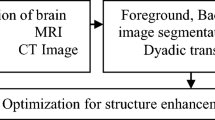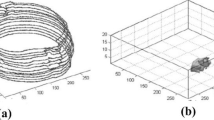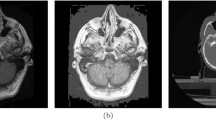Abstract
Radiologist diagnose the brain disease through shape and boundary regions of brain in medical image such as CT, MRI, and PET. Automatic medical image segmentation and enhancement method perform less in boundary regions due to artefacts such as dense objects and slice overlap. Manual enhancement and segmentation method never differentiates the shape and location of regions in brain CT/MRI images. Dyadic cat optimization (DCO) algorithm is proposed for segmenting brain regions in medical images such as CT and MRI through Nonlinear perspective Foreground and Background projection. DCO algorithm eliminates the artefacts in the boundary regions of brain and enhances the boundaries and shape such as pterygomaxillary fissure, occipital lobe, vaginal process, zygomatic arch, maxilla and piriform aperture for more visibility. Proposed DCO algorithm enhances the occipital lobe and zygomatic arch regions in CT/MRI image. The occipital lobe and zygomatic arch regions are better enhanced and segmented with DCO algorithm than traditional algorithm and achieve an accuracy of 90% through structural similarity index and visual interpretation.











Similar content being viewed by others
Data availability
The datasets used and/or analysed during the current study are available from the corresponding author on reasonable request.
References
Amindavar MAH (2012) Wavelet domain Bayesian processor for speckle removal in medical ultrasound images. IET Image Process 6:580–588
Chittajallu DR, Paragios N, Kakadiaris IA (2014) An explicit shape-constrained MRF-based contour evolution method for 2-D medical image segmentation. IEEE J Biomed Heal Inf 18(1):120–129
Dadkhah M, Kamgar R, Heidarzadeh H, Jakubczyk-Gałczyńska A, Jankowski R (2020) Improvement of performance level of steel moment-resisting frames using tuned mass damper system. Appl Sci 10(10):3403
Dadkhah M, Kamgar R, Heidarzadeh H (2021) Improving the nonlinear seismic performance of steel moment-resisting frames with minimizing the ductility damage index. SN Appl Sci 3(1):1–4
Doshi T et al (2016) Combining interpolation and 3D level set method ( I + 3DLSM ) for medical image segmentation. Electron Lett 52(8):592–594
Duan Y et al (2015) The L0 regularized mumford – shah model for bias correction and segmentation of medical images. IEEE Trans Image Process 24(11):3927–3938
Franchini S et al (2015) ConformalALU: a conformal geometric algebra coprocessor for medical image processing. IEEE Trans Comput 64(4):955–970
Kamgar R, Rahgozar P (2020) Optimum location for the belt truss system for minimum roof displacement of steel buildings subjected to critical excitation. Steel Compos Struct 37(4):463–479
Karasev P, Kolesov I, Fritscher K, Vela P, Mitchell P, Tannenbaum A (2013) Interactive medical image segmentation using PDE control of active contours. IEEE Trans Med Imaging 32(11):2127–2139
Khadidos A, Sanchez V, Li C (2017) Weighted level set evolution based on local edge features for medical image segmentation. IEEE Trans Image Process 26(4):1979–1991
Kuo J, Mamou J, Wang Y, Saegusa-beecroft E, Machi J, Feleppa EJ (2017) Segmentation of 3D high-frequency ultrasound images of human lymph nodes using graph cut with energy functional adapted to local intensity distribution. IEEE Trans Ultrason Ferroelectr Freq Control 64(10):1–12
Li C, Wang X, Eberl S, Fulham M, Yin Y, Feng DD (2015) Supervised variational model with statistical inference and its application in medical image segmentation. IEEE Trans Biomed Eng 62(1):196–207
Liu H et al (2017) Label fusion method based on sparse patch representation for the brain MRI image segmentation. IET Image Process Res 11(7):502–511
Pereira S, Pinto A, Alves V, Silva CA (2016) Brain tumor segmentation using convolutional neural networks in MRI images. IEEE Trans Onmed Imaging 35(5):1240–1251
Pratondo A, Chui C, Ong S (2016) Robust edge-stop functions for edge-based active contour models in medical image segmentation. IEEE Signal Process Lett 23(2):222–226
Qi GUO, Long W, Shuting S (2015) Multiple-channel local binary fitting model for medical image segmentation∗. Chin J Electron 24:4
Rahmani F, Kamgar R, Rahgozar R (2021) Optimum material distribution of porous functionally graded plates using carrera unified formulation based on isogeometric analysis. Mech Adv Mater Struct 1:1–5
Salimi M, Kamgar R, Heidarzadeh H (2021) An evaluation of the advantages of friction TMD over conventional TMD. Innov Infrastruct Solut 6(2):1–12
Tian J, Member S, Xue J, Dai Y, Chen J, Zheng J (2008) A novel software platform for medical image processing and analyzing. IEEE Trans Inf Technol Biomed 12(6):800–812
Von Landesberger T, Basgier D, Becker M (2015) Comparative local quality assessment of 3D medical image segmentations with focus on statistical shape model-based algorithms. IEEE Trans vis Comput Graph 22(12):2537–2549
Funding
No funding.
Author information
Authors and Affiliations
Corresponding author
Ethics declarations
Conflict of interest
None.
Ethical approval
All procedures were in accordance with the 1964 Helsinki Declaration (and its amendments). No approval by ethical committee or institutional review board was required.
Additional information
Publisher's Note
Springer Nature remains neutral with regard to jurisdictional claims in published maps and institutional affiliations.
Rights and permissions
Springer Nature or its licensor holds exclusive rights to this article under a publishing agreement with the author(s) or other rightsholder(s); author self-archiving of the accepted manuscript version of this article is solely governed by the terms of such publishing agreement and applicable law.
About this article
Cite this article
Partheepan, R., Perinbam, J.R.P., Krishnamurthy, M. et al. Visualization of occipital lobe and zygomatic arch of brain region through non-linear perspective projection using DCO algorithm. Soft Comput 26, 11599–11610 (2022). https://doi.org/10.1007/s00500-022-07427-8
Accepted:
Published:
Issue Date:
DOI: https://doi.org/10.1007/s00500-022-07427-8




